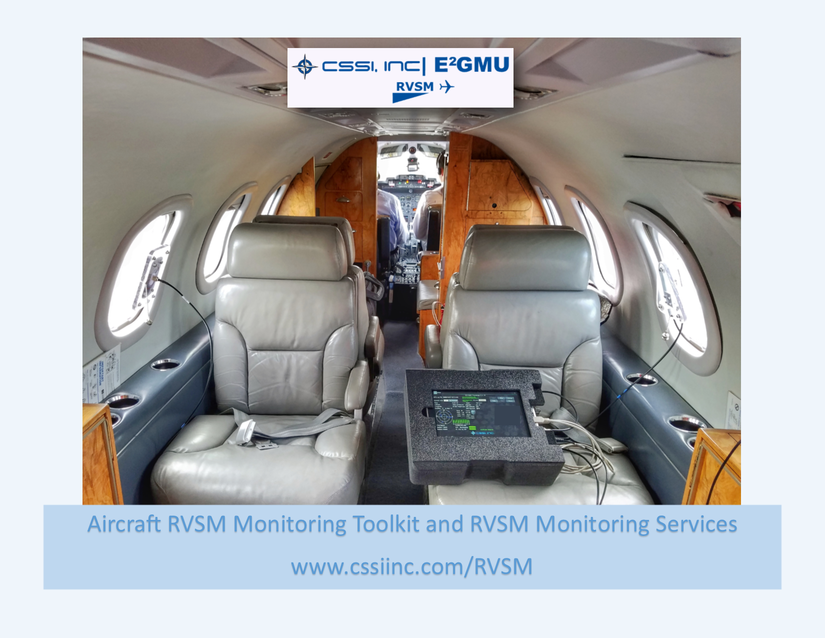GPS-Based Monitoring System (GMS)

The Enhanced Generation 2 GPS-based Monitoring Unit (E2GMU)
The E2GMU contains a GPS receiver, two portable shielded GPS antennas, and an Altitude Recording Device (ARD) to capture Mode-C data emitted by the aircraft's transponder. These components are contained within a case that meets airline standards for carry-on luggage. The E2GMU is considered a Portable Electronic Device and requires no STC for installation.
CSSI Inc. designed and manufacturers, under the guidance and specifications of the US Federal Aviation Administration, the Enhanced Generation 2 GPS based Monitoring Unit (E2GMU) as a portable electronic device for Reduced Vertical Separation Minima (RVSM) Monitoring of Aircraft. The E2GMU utilizes the latest in tablet computing devices, an open source software operating system foundation, and the latest GPS receiver specifications. The E2GMU system also features an integrated Altitude Recording Device (ARD) to capture aircraft pressure altitude with MODE C. The E2GMU, is classified as a portable electronic device powered completely independently from aircraft systems with contained rechargeable batteries. The E2GMU features a custom designed tablet software interface controller, which allows the user to transfer all recorded data from the tablet by using the device with a Wi-Fi or Bluetooth connection after the testing has completed.
The E2GMU uses an onboard OEM GPS Receiver board manufactured by JAVAD, Inc. The E2GMU receives GPS radio signals via Two (2) GPS antennas that are placed on aft and starboard interior aircraft windows and secured with suction cups. The E2GMU GPS receiver is calibrated for positional accuracy during the installation inside the aircraft while the aircraft is stationary on the ramp. The Altitude Recording Device (ARD) is calibrated by the operator by entering the 4 digit Transponder Code of the target aircraft to be monitored for RVSM performance. After the RVSM Monitoring flight is completed, CSSI, Inc. uses a Differential GPS Corrections software method to correct errors in the E2GMU GPS data.
The E2GMU RVSM Monitoring System does not require manufacturer calibration as the calibration occurs during the aircraft installation with GPS radio signal acquisition and after the RVSM Monitoring flight with CSSI Inc.’s software Differential GPS correction.
E2GMU Monitoring
The E2GMU supports the GPS-Based Monitoring System (GMS) by providing an on-demand means for operators to satisfy their RVSM monitoring requirements and is rapidly and transparently installed onboard aircraft without impact to aircraft systems and flight crews in the performance of their duties. Typical installation of the E2GMU requires a set up time of less than 15 minutes to temporarily install the equipment and place GPS antennas in the cabin or aft cockpit windows to permit data collection. The E2GMU and its components are battery powered. Once installed, the monitoring specialist will work with the flight crew to capture specific information in the Flight Information Form (FIF) relating to the monitoring flight.
RVSM Monitoring Flight Options/Procedures
Monitoring may be conducted on scheduled, ferry, or special test flights. The goal of monitoring is to collect a GPS data file during straight and level phases of flight while within the RVSM stratum (FL 290-410 inclusive) for approximately 30 minutes. CSSI is authorized to serve as a monitoring provider on behalf of RVSM airspace users. Specialists from CSSI routinely conduct monitoring flights after an operator has developed a schedule with our operations coordinator. Upon completion of a monitoring flight, CSSI performs the initial post-flight processing of the data which is then transmitted to the respective ICAO Regional Monitoring Authority (RMA) for further processing to calculate the aircraft's altimetry system error (ASE) with the results provided to the operator's State authority.

